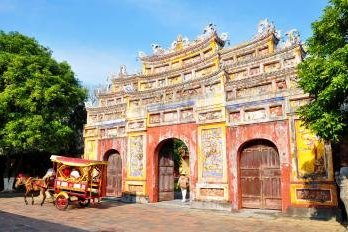
On my way to Danang Airport, I looked back on the past few days I spent in the former capital of Imperial Viet Nam, Hue, which in my opinion, one of the great cultural cities that actually should be on the same league with Beijing, Seoul or Kyoto, but after many wars and conflicts, only fragment of its glories remains. When I first saw the wall of Hue Citadel, I was really impressed as the wall is really different from other city wall I saw in other parts of Asia, a combination of Asian and French Vauban fortification design, something really unique. The Flag Tower is really impeccable in design and the square and pavilions next to the river are really picturesque. When I crossed the bridge to see inside the citadel, I again impressed for the design of the Gate Tower, simple but really elegant and when I saw the square in front of the main gate to the imposing Imperial Palace behind the flag tower, I said WOW immediately, for its perfect size and overall landscape design.
The palace is a bit simple but still preserved the original idea of oriental palace perfectly with many unique designs that I could not find anywhere else. Then I proceeded to other parts of the palace, and I found many empty spaces or ruins of destroyed buildings, only few structures still remained. The best-preserved area maybe the Ancestral Shrine, simple with Confucius element, a richer decorated version of Seoul’s Jongmyo Shrine; however, the gate is a real highlight. Actually, the best of the palace remains are its many beautiful gates. These gates are elegantly rich in decoration with mosaic of broken porcelains and glazed tiles. The recent palace restoration part is really amazing that provide an idea of how impressive the site originally was. The decayed of other buildings really made me sad of how war and neglecting effect this beautiful place; at the end I found that the site is disappointing. Fortunately, the saving grace of Hue comes from other Hue’s cultural heritages in my opinion. There are many temples and tombs around the city, and one of the major highlights is the Tomb of Tu Duc, the fourth emperor of Hue. Originally, he built this complex as his villa, after his death the complex has been transformed to be his tomb and temple, so the landscape design is really beautiful. The pond and pavilion reminded me the secret garden of Korea’s Changdeokgung Palace, ironically Korean tourists were everywhere during my visit. The tomb design itself is really unique and different from China and other East Asian countries. There is no tumulus or earth mound. Another highlight is the Tomb of Khai Dinh, the 12th Emperor. This is the smallest tomb but very beautiful and different. The tomb built on many terraces, and with one single main building that used as tomb, temple and memorial hall. The design is a unique mix of western and local art and built by concrete and marble which made the complex in the better condition. The decorations are really impressive for both exterior and interior. The walls inside the main hall are richly decorated with beautiful mosaic, glazed tiles and paintings, truly one of the must-see site in Vietnam.
As I mentioned above that Hue is the great cultural city that actually should be on the same league with Beijing, Seoul or Kyoto. I really wondered if there is no Vietnam War, what Hue will be looked like as even after the wars, Hue still has a lot of cultural sites to admire, really a capital of powerful kingdom in mainland Southeast Asia before colonial time. The continuing restoration project of Hue is a good thing that bring back the bygone magnificent of this city and I believe Hue will become one of the great World Heritage Site of Asia, and a must see to every traveler in the near future.
More on
Comments
No comments yet.
